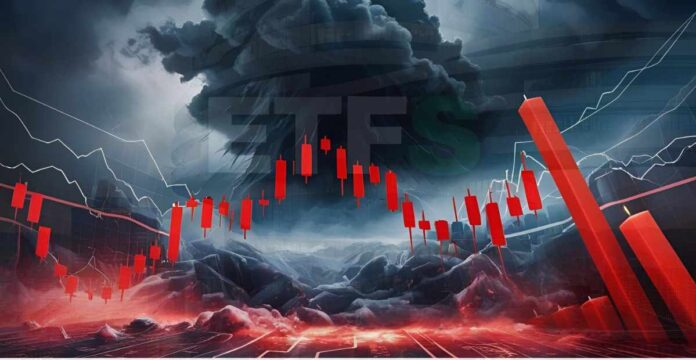Leveraged exchange-traded funds (ETFs) are a financial instrument designed to amplify the daily returns of an underlying index, often by a factor of 2x or 3x. These funds use financial derivatives and debt to achieve their leveraged exposure, making them attractive to short-term traders looking to maximize potential gains.
However, the very mechanism that makes leveraged ETFs appealing also exposes them to risks, particularly decay over time due to compounding effects. Many investors wonder: Can leveraged ETFs go to zero? The answer lies in how these funds function, how market volatility impacts them, and the effects of long-term holding.
How Leveraged ETFs Work
Unlike traditional ETFs that aim to mirror the performance of an index, leveraged ETFs reset their exposure daily. This means that their returns compound differently than a simple multiple of the index over time. If the market moves in a consistent direction, leveraged ETFs can significantly outperform expectations. However, in volatile markets, frequent rebalancing can lead to substantial losses over time.
The Role of Daily Compounding
One of the key issues with leveraged ETFs is their reliance on daily compounding. This means that they do not produce the expected return of an index multiplied by the leverage factor over extended periods. Instead, the returns fluctuate based on daily price movements, which can erode value over time—a phenomenon known as volatility decay or beta slippage.
For example, if a leveraged ETF aims to deliver 2x the daily return of an index and that index falls 5% one day and then rises 5% the next day, the ETF’s value does not return to its original level. Instead, due to compounding, it falls slightly lower than expected. Over weeks and months, this effect accumulates, leading to significant long-term underperformance.
Can Leveraged ETFs Go to Zero?
While it is possible for leveraged ETFs to go to zero, it is relatively uncommon under normal market conditions. However, there are a few scenarios where this could happen:
1. Extreme Market Volatility
During periods of extreme volatility, leveraged ETFs can suffer severe losses. If the underlying index experiences a rapid and sustained drop, the leveraged ETF can potentially lose all its value. This is particularly true for inverse leveraged ETFs, which are designed to move in the opposite direction of an index.
2. Continuous Downward Trend
If an index undergoes a prolonged decline, a leveraged ETF that tracks it could steadily erode in value. Since these ETFs reset daily, a long-term downward trend can make it difficult to recover, leading to substantial losses and, in extreme cases, complete depletion.
3. Structural Risks and Fees
Leveraged ETFs are subject to high management fees, typically ranging from 0.75% to 1.5%, which eat into returns over time. Additionally, the use of swaps, futures contracts, and other derivatives introduces counterparty risk. If market conditions become highly unfavorable, issuers may choose to liquidate the fund, causing investors to lose their holdings.
Historical Examples of Leveraged ETFs Going to Zero
While rare, there have been cases where leveraged ETFs have effectively gone to zero due to excessive volatility or poor market conditions. A notable example occurred during the 2008 financial crisis, when certain inverse and leveraged funds faced extreme losses. More recently, during the March 2020 market crash, some leveraged ETFs saw dramatic drops in value, forcing issuers to close or adjust the funds.
How Investors Can Protect Themselves
If you are considering investing in leveraged ETFs, there are several strategies to mitigate risks:
1. Use Leveraged ETFs for Short-Term Trading
Leveraged ETFs are best suited for short-term trades rather than long-term investments. Holding these funds for extended periods can expose investors to compounding decay, making it essential to monitor positions daily.
2. Set Stop-Loss Orders
Due to their volatile nature, it is wise to use stop-loss orders to prevent catastrophic losses. Setting automatic exit points can help traders manage risk effectively and avoid complete capital erosion.
3. Understand the Fund Structure
Before investing, always read the ETF’s prospectus to understand its expense ratios, rebalancing policies, and risk exposure. Some funds offer better liquidity and tighter spreads, making them less prone to slippage.
4. Monitor Market Conditions
Leveraged ETFs perform best in trending markets rather than choppy, sideways markets. Watching for strong directional trends can help investors capitalize on potential gains while minimizing compounding decay.
Are Leveraged ETFs a Good Investment?
Leveraged ETFs can be profitable for experienced traders who understand their risks and mechanisms. However, for long-term investors, they are generally not recommended due to the structural decay over time. Instead, long-term investors may be better off with traditional ETFs or sector-specific funds that align with their investment strategy.
Final Thoughts
So, can leveraged ETFs go to zero? Yes, under extreme circumstances, but it is not a common occurrence. The combination of daily rebalancing, volatility decay, and prolonged downturns can erode value significantly, making them high-risk instruments. Investors should approach leveraged ETFs with caution, use them strategically for short-term trading, and always have a risk management plan in place.

